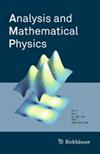质量次临界分数 NLS方程受约束最小化的极限行为
IF 1.4
3区 数学
Q1 MATHEMATICS
引用次数: 0
摘要
本文研究了受约束最小化问题解的渐近特性。$$\begin{aligned} d_{b_p}(p):=\inf _\{u\in H^s_V({\mathbb {R}}^2):\int _{{mathbb {R}}^2}|u|^2dx=1\}}I_{p,b_p}(u), \end{aligned}$$ 其中 \(s\in (\frac{1}{2},1),\)\(p\in (0, 2s)\),\(b_p>0\) and $$$\begin{aligned}I_{p,b_p}(u){:=}\frac{1}{2}\int _{{\mathbb {R}}^2}}\left( |(-\Delta )^{\frac{s}{2}}}u|^2{+}V(x)|u|^2\right) dx{-}\frac{b_p}{p+2}\int _{{\mathbb {R}}^2}|u|^{p+2}dx,\quad u\in H^s_V({\mathbb {R}}^2).\end{aligned}$$First, when \(\lim _{p\nearrow 2s}b_p=b<b^*\), the set of minimizers of \(d_{b_p}(p)\) is compact in a suitable space as \(p/nearrow 2s\)。此外,当 \(\lim _{p\nearrow 2s}b_p=b\ge b^*\)时,通过为一些精细的能量估计建立合适的试函数,我们证明了所有的最小值都必须炸毁,并给出了最小值的衰变特性。本文章由计算机程序翻译,如有差异,请以英文原文为准。
Limiting behaviors of constrained minimizers for the mass subcritical fractional NLS equations
In this paper, we study the asymptotic properties of solutions for the constrained minimization problems.
$$\begin{aligned} d_{b_p}(p):=\inf _{\{u\in H^s_V({\mathbb {R}}^2): \int _{{\mathbb {R}}^2}|u|^2dx=1\}}I_{p,b_p}(u), \end{aligned}$$
where \(s\in (\frac{1}{2},1),\) \(p\in (0, 2s)\), \(b_p>0\) and
$$\begin{aligned} I_{p,b_p}(u){:=}\frac{1}{2}\int _{{\mathbb {R}}^2}\left( |(-\Delta )^{\frac{s}{2}}u|^2{+}V(x)|u|^2\right) dx{-}\frac{b_p}{p+2}\int _{{\mathbb {R}}^2}|u|^{p+2}dx,\quad u\in H^s_V({\mathbb {R}}^2). \end{aligned}$$
First, when \(\lim _{p\nearrow 2s}b_p=b<b^*\), the set of minimizers of \(d_{b_p}(p)\) is compact in a suitable space as \(p\nearrow 2s\). In addition, when \(\lim _{p\nearrow 2s}b_p=b\ge b^*\), by developing suitable trial functions for some fine energy estimates, we prove that all minimizers must blow up and give decay properties of minimizers.
求助全文
通过发布文献求助,成功后即可免费获取论文全文。
去求助
来源期刊

Analysis and Mathematical Physics
MATHEMATICS, APPLIED-MATHEMATICS
CiteScore
2.70
自引率
0.00%
发文量
122
期刊介绍:
Analysis and Mathematical Physics (AMP) publishes current research results as well as selected high-quality survey articles in real, complex, harmonic; and geometric analysis originating and or having applications in mathematical physics. The journal promotes dialog among specialists in these areas.
 求助内容:
求助内容: 应助结果提醒方式:
应助结果提醒方式:


